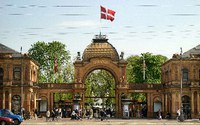Moving to Denmark? | Fundamentals of Living in Denmark
All You Need to Know About Moving to and Living in Denmark
DENMARK
|
|
PAGURO EXPAT CITY GUIDE A must read for any expat moving to Copenhagen |
|---|
The Kingdom of Denmark, is the smallest and most southern of the Scandinavian countries. Queen Margrethe II, the ruling monarch since January 14th, 1972 is very much loved and appreciated by the Danes.
The population of Denmark, whose territory consists mainly of islands and sea, is a little more than 5 million. The peninsula of Jutland, the only 'connection' to Europe, borders with Germany and then there are some 443 named islands, only 76 of which are inhabited. The biggest island is Seeland (Sjælland) where the capital Copenhagen, København in Danish, is situated. Denmark's sea territory represents a vast part of its dominion (more than 100.000 km2), not to mention Greenland which is still a Danish possession.
The country's average height above sea level is 31 m, obliging anyone who loves mountain related activities to travel abroad (if you are moving to Denmark, start planning your ski-holidays overseas!).
Denmark, like its Scandinavian neighbours, has been historically considered to have one of the most liberal cultures in the world, which is reflected in decisions taken at government level about very controversial issues such as pornography (Denmark was the first country to legalize pornography in 1969) and same sex marriage (again in 1989 Denmark was the first country in the world to grant same-sex couples all the rights and responsibilities of marriage as registered partnerships).
Denmark's standard of living is very high, in part due to strong and extensive welfare measures. The market economy is represented by a modern small-scale and corporate industry a highly efficient agriculture sector, which is highly dependent on foreign trade. The work force is strongly unionized with 75% of its labour force being members of a trade union. Trade unions cooperate with employers regularly, with representatives often included in corporate boards and often with a day-to-day involvement in managing the workplace. Agreements about updating or modifications of work contracts are usually negotiated between unions and employers, with little or no government involvement.
Unemployment rate is below 3.5%, and future projections point to an even lower rate.
The Danish welfare model is supported by a taxation system represented by a high income tax rates (minimum tax rate for adult workers is nearly 40%) and a broad based tax (25% VAT and excise).
The krone (DKK), the Danish currency, is a stable one. In September 2000, despite Denmark meeting all criteria for the Economic and Monetary Union of the European Union (EMU), a referendum rejected it, and the country retained its own currency. The krone is linked to the euro through the European Exchange Rate Mechanism (ERM) and in August 2007 one euro was roughly equivalent to 7.5 kroner.
Denmark, with almost 9,400 locally based multinationals, is an extreme example of the explosive growth of multinational firms worldwide (63,000 multinationals by 2000 compared to 7,258 known multinationals in 1969, according to some estimates).
Among them A.P. Moller-Maersk Group (Maersk - international shipping), Lego (children's toys), Bang & Olufsen (hi-fi equipment), Danfoss and the pharmaceutical companies Lundbeck and Novo Nordisk.
It is no surprise to discover that Denmark is a highly sought after destination for expatriates.


